当前位置:网站首页>Comparison of usage scenarios and implementations of extensions, equal, and like in TS type Gymnastics
Comparison of usage scenarios and implementations of extensions, equal, and like in TS type Gymnastics
2022-07-06 07:29:00 【Jioho_】
TS Type gymnastics And extends,Equal,Alike Use scenario and implementation comparison
In the program , Judging equality is a very important content , stay TS Equal in judgment ( In fact, it belongs to xxx Range ) It's using extends. Only extends Nature is not enough , So there are many tool classes that have some very subtle skills to implement Strictly equal The function of
Next, we will talk about several tool classes
EqualandAlike. this 2 It's not TS The official realization of , And in TS The tools encapsulated by the great God in the warehouse of gymnastics practice
extends The role of
Let's review extends And most application scenarios
// - 1
type ID = string | number
type TestID = ID extends string ? true : false // false
type TestID2 = string extends ID ? true : false // true
// - 2
type UnionType = string | number | boolean
type testUnion = string extends UnionType ? true : false // true
type testUnion2 = [string] extends [UnionType] ? true : false // true
type testUnion3 = [UnionType] extends [string] ? true : false // false
above 2 In one case
ID yes string/number type , therefore ID The range of values is ratio string The range of types is large ,TestID The return value is naturally false 了
And one string type , yes stay string|number Within the scope of , So naturally true 了
The same is true for others in the array
Understand the principle of the above example , That's it 
use extends The characteristics of the solution 01097-medium-isunion
extends It is a judge with its own range judgment , As long as it is within the scope of another type , It will be judged as true
01097-medium-isunion The demand of the topic : Determine whether an incoming type union type
What is? union( union ) Type? , It consists of multiple types union And become , among
|Just for Glue multiple types
The test cases are as follows : Very representative
type cases = [
Expect<Equal<IsUnion<string>, false >>,
Expect<Equal<IsUnion<string|number>, true >>,
Expect<Equal<IsUnion<'a'|'b'|'c'|'d'>, true >>,
Expect<Equal<IsUnion<undefined|null|void|''>, true >>,
Expect<Equal<IsUnion<{ a: string }|{ a: number }>, true >>,
Expect<Equal<IsUnion<{ a: string|number }>, false >>,
Expect<Equal<IsUnion<[string|number]>, false >>,
// Cases where T resolves to a non-union type.
Expect<Equal<IsUnion<string|never>, false >>,
Expect<Equal<IsUnion<string|unknown>, false >>,
Expect<Equal<IsUnion<string|any>, false >>,
Expect<Equal<IsUnion<string|'a'>, false >>,
]
According to the above extends Introduction to , We can use the following principles to solve this problem
string extends string | numberby truestring | number extends stringby false- TS In gymnastics Union( Joint type ) automatically “ deconstruction ”
The answer is as follows :
type IsUnion<T,U = T> = T extends U ? U extends T ? false : true : false
stay IsUnion Inside ,T It's automatic “ deconstruction ”, Like What's coming in is string|number.
- T It will automatically become string, And then U Compare
- T It's becoming number , In the and U Compare
- U Empathy become string and T(string/number) Compare
So it looks like T extends U Just a trinocular operator , In fact, they Already run 4 It's a comparison , Just one time for false, that extends The result is false
Don't believe it ? Insert a digression to prove
Let's change the type to 'a' | 'b', This is also a union type , And then we put extends Replace them 2 Splices
type TestUnion<T extends string, U extends string = T> = `${T}-${U}`
type ResultUnio = TestUnion<'a' | 'b'>
// type ResultUnio = "a-a" | "a-b" | "b-a" | "b-b"
After seeing the results , You should be able to understand the above ,union The type will be automatically “ deconstruction ” It means ,T Will be automatically deconstructed to a and b,U It will also be automatically deconstructed into a and b, Then pair them in pairs ; The result is ( What I don't understand is pondering )
Can understand this demo after , There are several questions that will use this knowledge point , Circle to test
End of digression
Back to a few examples of test cases
{ a: string|number }and[string|number]It's not a union type , Because they all belong to the same object , their Attribute values are union types , And they themselves are notThe last thing left 4 Of the test cases , such as
string|never,string|'a'It also does not meet Union of multiple types The meaning of- never Note that no type matches , It's like whether sterilized kittens and normal kittens can give birth to new kittens ? No way . So they Cannot unite
- as for
string|'a'‘a’ It belongs to string Type of , It's like A male kitten and a male black kitten , They can union Do you ? They all belong toMale cat, Only union , The union cannot produce results - therefore
string|anySame as above ,any Everything , Nothing can be compared with any Form a union
however ! Although they cannot form a joint type , But this will not report an error , Like this Take off your pants and fart
TS It will automatically help them choose a type with a large range as the joint result
like A male kitten and a male black kitten , They are collectively called Male cat
type StringUnion = string | 'a' // The result is string
type StringUnion2 = string | any // The result is any
Use tips to achieve Equal Congruent judgment
Want to say Equal Usage scenarios of ,TS Every exercise question of type gymnastics is used
I was in 
type User = {
name?: string
age: number
address: string
}
type User2 = {
name?: string
} & {
age: number
address: string
}
type R = Equal<User1, User2> // false
type R2 = User1 extends User2 ? (User2 extends User1 ? true : false) : false // true
Look at the above. demo, If only extends To judge , They are equal (U1 == U2 && U2 == U1)
But there are differences in writing ,User2 It is crossed by cross type
That's why extends The reason why we can't do exactly the same
So there it is Equal The plan , have a look Equal The implementation of the
export type Equal<X, Y> =
(<T>() => T extends X ? 1 : 2) extends
(<T>() => T extends Y ? 1 : 2) ? true : false
At first, I thought for a long time
- T It came out there ?
- T As a generic , Pass into a function , Then come back ?
- T Why is it equal to X ?
- T Why is it equal to Y 了 ?
Finally, I see the answer here , A little feeling How does the Equals work in typescript?
According to the principle of looking at brackets first hold Equal The equation of is divided into 3 From the content of this paragraph
(<T>() => T extends X ? 1 : 2)Assuming that 1 type(<T>() => T extends Y ? 1 : 2)Assuming that 2 type
All in all : 1 type extends 2 type ? true : false
and <T>() How do you understand that ? There is a very important sentence ( Also from stackoverflow Answers on )
The assignability rule for conditional types <…> requires that the types after extends be “identical” as that is defined by the checkerF
Corresponding translation : Condition type <…> The allocability rule of requires the extended type and the type defined by the inspector “ identical ”
According to the above 1 type ,2 type To a demo Understanding :
declare let x: <T>() => T extends number ? 1 : 2
declare let y: <T>() => T extends number ? 1 : 2
declare let z: <T>() => T extends string ? 1 : 2
var str: string = '1'
str = 2 // Report errors
x = 100 // Report errors
x = y
x = z // Report errors
y = z // Report errors
- 2 Assign a value to str When an error Type ‘number’ is not assignable to type ‘string’.
- x The assignment is 100 When an error Type ‘number’ is not assignable to type ‘<T>() => T extends number ? 1 : 2’.
Watch this carefully 2 Error messages , They all belong to
ts(2322)Wrong number . Then it can be understood as<T>() => T extends number ? 1 : 2Actually andstringequally , It's a Single type , Not what we think function
y Assign a value to x Nothing
z Assign a value to x and z Assign a value to y Will prompt the following error
Type '<T>() => T extends string ? 1 : 2' is not assignable to type '\<T\>() => T extends number ? 1 : 2'.
Type 'T extends string ? 1 : 2' is not assignable to type 'T extends number ? 1 : 2'.
Type '1 | 2' is not assignable to type 'T extends number ? 1 : 2'.
Type '1' is not assignable to type 'T extends number ? 1 : 2'.
To put it bluntly, there are different types Can't assign a value , because The allocability rule requires the extended type and the type defined by the inspector “ identical ”
See here , Is it possible to understand ?1 type and 2 In fact, the final form is just an exaggerated one type . And then the little tail (1 and 2, It's really to make up the number of words , in order to extends It's used for rounding up the number of words )
For example, change it a little , The equations are all wrong 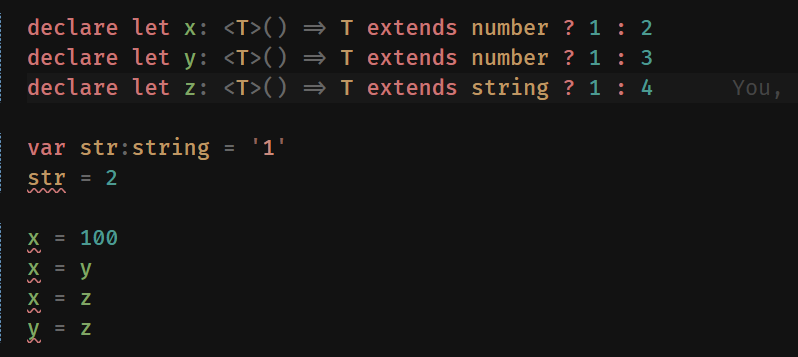
Change the definition of generics , It won't report an error
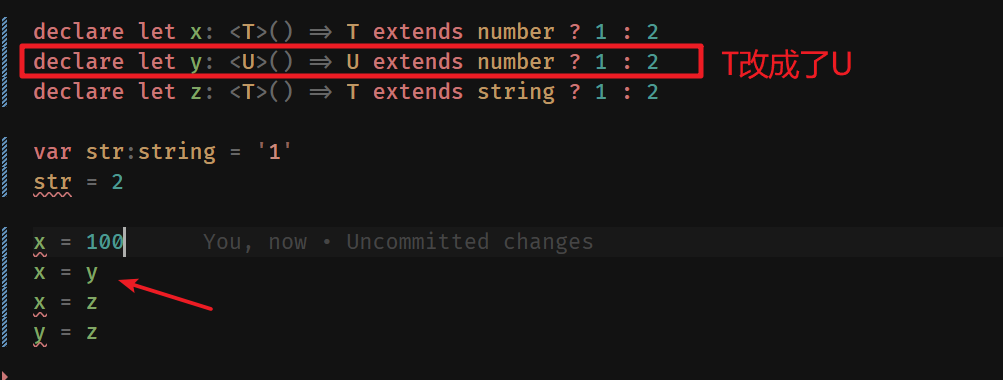
To sum up, it's the same sentence
Condition type <…> The allocability rule of requires the extended type and the type defined by the inspector “ identical ”
I understand demo And parsed text , So understand Equal Not to mention , as long as 1 The type and 2 type extends, Based on the above “ identical ” characteristic , That's all waiting
and Equal Much like the Alike
Alike and Equal The same is to judge equality , In the previous article 《TS Type gymnastics And Key value judgment in the loop ,as Keyword use 》 It's said in 
type User = {
name?: string
age: number
address: string
}
type User2 = {
name?: string
} & {
age: number
address: string
}
// hold Equal Switch to Alike What you get is true Result
type R = Alike<User1, User2> // true
type R2 = User1 extends User2 ? (User2 extends User1 ? true : false) : false // true
If you use Alike, So just now Equal by false Of 2 An object can be changed into true 了
Alike It cannot be simply understood as T extends U && U extends The implementation of the , Absolutely not
- Alike The implementation is as follows :
export type MergeInsertions<T> = T extends object ? {
[K in keyof T]: MergeInsertions<T[K]> } : T
export type Alike<X, Y> = Equal<MergeInsertions<X>, MergeInsertions<Y>>
Used MergeInsertions Tool class of , The function of this is the same as yesterday type Clone<T> = Pick<T, keyof T> almost ! Just say mine Pick Can only Pick First floor , and MergeInsertions It takes into account the multi-layer nesting of objects ( Upgraded version Clone, It means a little shallow copy and deep copy )
{} & {} after MergeInsertions After processing , It will also be merged into an object {}, Then take it Equal contrast . Have to say , That's wonderful
above-mentioned Alike It cannot be simply understood as T extends U && U extends The implementation of the
Look at a case :
type TestUnion = {
a: string } | {
a: number }
type IsLike = Alike<TestUnion, TestUnion> // true
type IsUnionResult = IsUnion<TestUnion> // true
type IsLike2 = Alike<string, string> // true
type IsUnionResult2 = IsUnion<string, string> // false
For a single type ,T extends U && U extends Can determine whether Union , and Alike We can only judge whether they are equal
So if you want to judge IsUnion We have to rely on double extends,Alike Just a loose equality operator
summary
- extends It's a Comparison of subsets , as long as x yes y Subset , that x extends y for true
- Determine whether a type is union type , It also uses extends A subset of Characteristics
- If x yes y Subset , that y It can't be x Subset
- x extend y also y also extends x Words , It can only be said that they are A single The type of , There is no union
- Equal The function is cleverly used TS A feature of
The assignability rule for conditional types <...> requires that the types after extends be "identical" as that is defined by the checkerF- Through a similar Formula substitution Scene judgment 2 Are the types Congruence
- Single type and Cross type
Incongruence
- If you want to relax the conditions , Just want to judge 2 If all fields of a type are the same, they are equal
- Just use Alike ,Alike It uses a
MergeInsertions(Clone Upgraded version ) To merge cross types into Single type - With a single type , You can use it Equal To compare
- For a single type ,T extends U && U extends Can determine whether Union , and Alike We can only judge whether they are equal ( So don't confuse Alike and IsUnion Implementation principle of )
- Just use Alike ,Alike It uses a
Whether it's IsUnion Implementation principle of , still Alike Loose grammar contrast ,Equal Strict congruence of ,extends Range subset judgment ; All have their own use scenarios , Do questions everyday / Development should Look at the scheme below
边栏推荐
- jmeter性能测试步骤实战教程
- [CF Gym101196-I] Waif Until Dark 网络最大流
- Project GFS data download
- TypeScript void 基础类型
- The differences and advantages and disadvantages between cookies, seeion and token
- Ble of Jerry [chapter]
- Ble of Jerry [chapter]
- js对象获取属性的方法(.和[]方式)
- Ali's redis interview question is too difficult, isn't it? I was pressed on the ground and rubbed
- Bugku CTF daily question: do you want seeds? Blackmailed
猜你喜欢

qt颜色与字符串、uint相互转换
![[MySQL learning notes 32] mvcc](/img/0d/2df82b63d1eb3283a84e27f67c1523.png)
[MySQL learning notes 32] mvcc
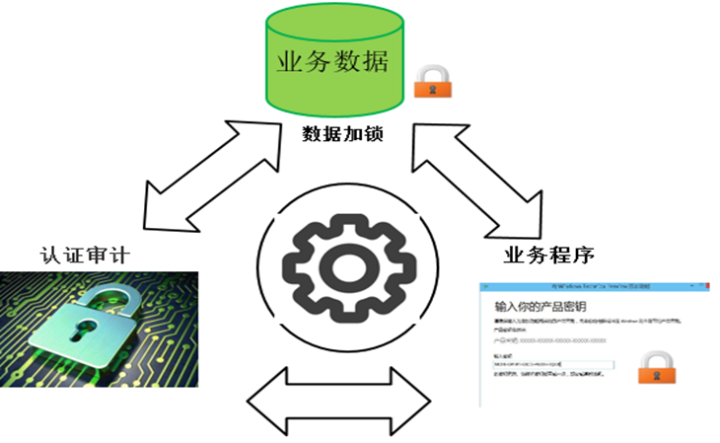
智能终端设备加密防护的意义和措施
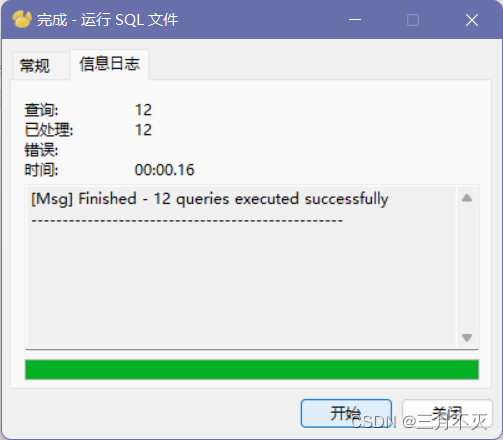
How Navicat imports MySQL scripts
![If Jerry needs to send a large package, he needs to modify the MTU on the mobile terminal [article]](/img/57/12a97ab3d2dabfaf06bbe1788450cf.png)
If Jerry needs to send a large package, he needs to modify the MTU on the mobile terminal [article]
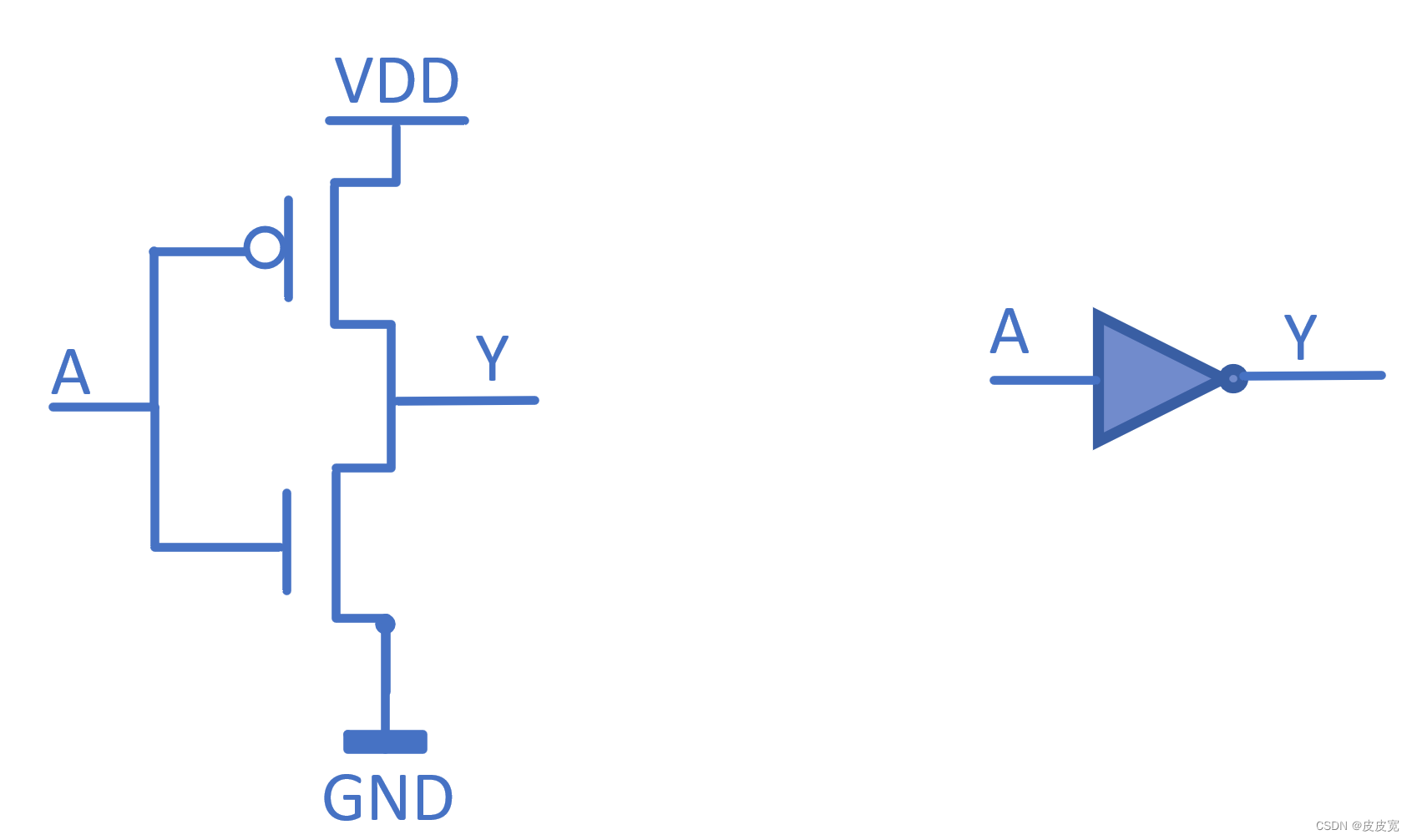
Summary of Digital IC design written examination questions (I)

The ECU of 21 Audi q5l 45tfsi brushes is upgraded to master special adjustment, and the horsepower is safely and stably increased to 305 horsepower
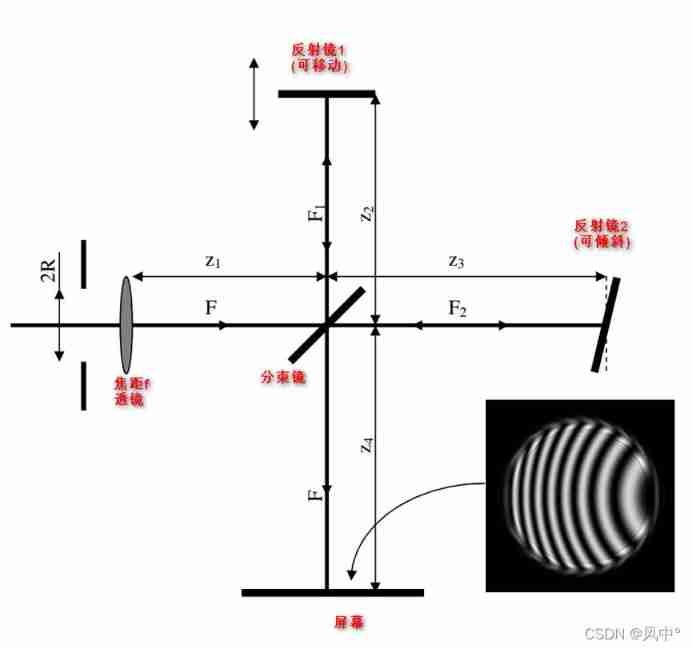
Simulation of Michelson interferometer based on MATLAB
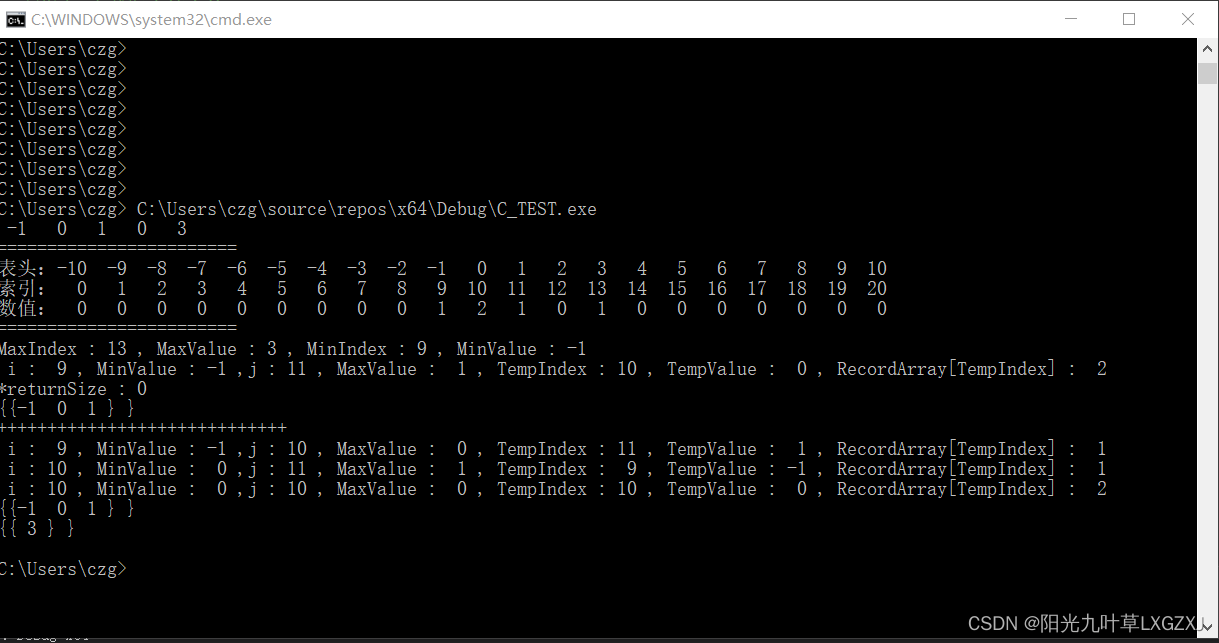
leecode-C語言實現-15. 三數之和------思路待改進版
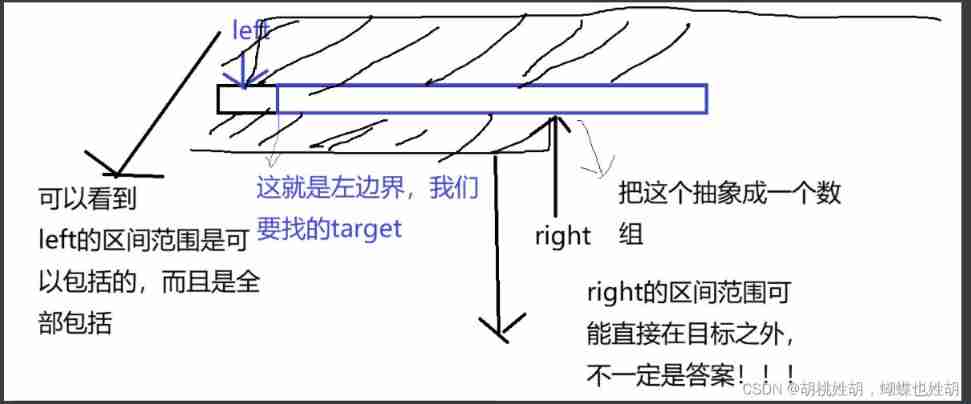
Do you really think binary search is easy
随机推荐
MVVM of WPF
How MySQL merges data
Path analysis model
mysql如何合并数据
C - Inheritance - hidden method
Introduction to the basics of network security
Get/post/put/patch/delete meaning
The best way to learn SEO: search engine
【MySQL学习笔记32】mvcc
Jerry's ad series MIDI function description [chapter]
word中把带有某个符号的行全部选中,更改为标题
Go learning -- implementing generics based on reflection and empty interfaces
How are the open source Netease cloud music API projects implemented?
Résumé de la structure du modèle synthétisable
智能终端设备加密防护的意义和措施
CF1036C Classy Numbers 题解
Simple and understandable high-precision addition in C language
word中如何删除某符号前面或后面所有的文字
Typescript void base type
软件测试界的三无简历,企业拿什么来招聘你,石沉大海的简历